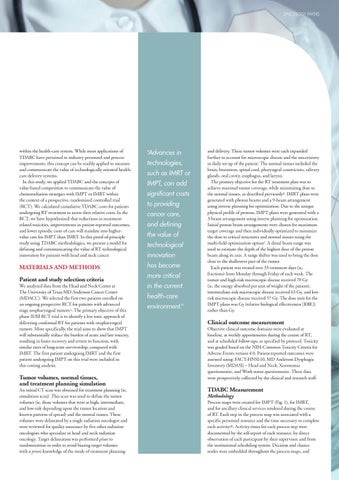ONCOLOGY PAYERS
within the health-care system. While most applications of TDABC have pertained to industry personnel and process improvements, this concept can be readily applied to measure and communicate the value of technologically oriented healthcare delivery systems. In this study, we applied TDABC and the concepts of value-based competition to communicate the value of chemoradiation strategies with IMPT or IMRT within the context of a prospective, randomized controlled trial (RCT). We calculated cumulative TDABC costs for patients undergoing RT treatment to assess their relative costs. In the RCT, we have hypothesized that reductions in treatmentrelated toxicities, improvements in patient-reported outcomes, and lower episodic costs of care will translate into highervalue care for IMPT than IMRT. In this proof-of-principle study using TDABC methodologies, we present a model for defining and communicating the value of RT technological innovation for patients with head and neck cancer
MATERIALS AND METHODS Patient and study selection criteria We analyzed data from the Head and Neck Center at The University of Texas MD Anderson Cancer Center (MDACC). We selected the first two patients enrolled on an ongoing prospective RCT for patients with advanced stage oropharyngeal tumors19. The primary objective of this phase II/III RCT trial is to identify a less toxic approach of delivering conformal RT for patients with oropharyngeal tumors. More specifically, the trial aims to show that IMPT will substantially reduce the burden of acute and late toxicity, resulting in faster recovery and return to function, with similar rates of long-term survivorship, compared with IMRT. The first patient undergoing IMRT and the first patient undergoing IMPT on this trial were included in this costing analysis.
Tumor volumes, normal tissues, and treatment planning simulation An initial CT scan was obtained for treatment planning (ie, simulation scan). This scan was used to define the tumor volumes (ie, those volumes that were at high, intermediate, and low-risk depending upon the tumor location and known patterns of spread) and the normal tissues. These volumes were delineated by a single radiation oncologist and were reviewed for quality assurance by five other radiation oncologists who specialize in head and neck radiation oncology. Target delineation was performed prior to randomization in order to avoid biasing target volumes with a priori knowledge of the mode of treatment planning HTTP://OPPP.US
"Advances in technologies, such as IMRT or IMPT, can add significant costs to providing cancer care, and defining the value of technological innovation has become more critical in the current health-care environment."
and delivery. These tumor volumes were each expanded further to account for microscopic disease and the uncertainty in daily set-up of the patient. The normal tissues included the brain, brainstem, spinal cord, pharyngeal constrictors, salivary glands, oral cavity, esophagus, and larynx. The primary objective for the RT treatment plan was to achieve maximal tumor coverage, while minimizing dose to the normal tissues, as described previously8. IMRT plans were generated with photon beams and a 9-beam arrangement using inverse planning for optimization. Due to the unique physical profile of protons, IMPT plans were generated with a 3-beam arrangement using inverse planning for optimization. Initial proton beam arrangements were chosen for maximum target coverage and then individually optimized to minimize the dose to critical structures and normal tissues using the multi-field optimization option7. A distal beam range was used to estimate the depth of the highest dose of the proton beam along its axis. A range shifter was used to bring the dose close to the shallowest part of the tumor. Each patient was treated over 33 treatment days (ie, fractions) from Monday through Friday of each week. The tumor and high-risk microscopic disease received 70 Gy (ie, the energy absorbed per unit of weight of the patient), intermediate-risk microscopic disease received 63 Gy, and lowrisk microscopic disease received 57 Gy. The dose unit for the IMPT plans was Gy (relative biological effectiveness [RBE]) rather than Gy.
Clinical outcome measurement Objective clinical outcome domains were evaluated at baseline, at weekly appointments during the course of RT, and at scheduled follow-ups, as specified by protocol. Toxicity was graded based on the NIH-Common Toxicity Criteria for Adverse Events version 4.0. Patient-reported outcomes were assessed using: FACT-HNSI-10, MD Anderson Dysphagia Inventory (MDASI) – Head and Neck, Xerostomia questionnaire, and Work status questionnaire. These data were prospectively collected by the clinical and research staff.
TDABC Measurement Methodology Process maps were created for IMPT (Fig. 1), for IMRT, and for ancillary clinical services rendered during the course of RT. Each step in the process map was associated with a specific personnel resource and the time necessary to complete each activity20. Activity times for each process step were documented by the self-report of each resource, by direct observation of each participant by their supervisor, and from the institutional scheduling system. Decision and chance nodes were embedded throughout the process maps, and 23
